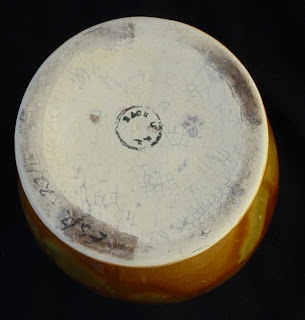Among Crown Lynn enthusiasts there's a lot of interest in trickle glazed items - mainly vases and animal figurines. The trickle glazing technique was first used at Ambrico (before it became Crown Lynn) in the late 1930s and refined through the 1940s. A single colour of glaze was applied to an item - eg this vase below. Then another colour was applied - as you can see, it was sort of slopped on. Sometimes another colour was added. The effects are often quite lovely.
This (above) is a vase from my collection. It is about 16 cm tall.
This is another from my collection. It too is trickle glazed, and it's about 16 cm tall. It is a very common Crown Lynn/Ambrico shape. There is usually a mark on the base of these vases, but not always. The base of my brown vase looks like this:
The small circular mark says 'Made in N.Z' which was an early stamp used by Ambrico. I will go into more detail about marks in a couple of weeks. (I have a new camera and I have to get it organised before I can take the necessary photos!)
Trickle glazing was used a great deal from the early 1940s until around 1948, which is 60+ years ago. At that time, they didn't have the skills or the materials to use other 'English style' types of decoration - eg applying coloured transfers, painting on gold lines etc. So they made use of the skills and materials they had, to create some truly beautiful and idiosyncratic ornaments.
These early trickle glazed items are sought after, especially the more elegant shapes with lively colours. Below is a photo (rather poor quality I am afraid) which gives an indication of the range of shapes and colours around.
There are some brilliant websites which add enormously to our knowledge of Crown Lynn and other NZ pottery. One can only be grateful to the the people who set up and maintain these sites, and the enthusiasts who so generously share their knowledge on them. Try these:
Trickle glaze techniques were used after the 1940s - eg this 1970s mug which I featured earlier has a trickle glaze top. However these later examples are not as collectible as the earlier vases and figurines.
More soon... I try to update once a week. ValM





Interesting, I have a trickle glaze hare with what I believe is that stamp. Always found it hard to believe it was CL as didn't think the specials dept used a stamp of any kind.
ReplyDeleteAre you aware of the Crown Lynn Shape Guide on the Collectiques site? Have a look and see if you can see your item on their excellent catalogue. http://www.collectiques.co.nz/crownlynn.html
ReplyDeleteAny chance of you listing out the known animals with their sizes. They seem to appear on TM ranging from quite small to medium to bigger so it is hard to know what is genuine. Elephants for examples, do these come in different sizes and if so what are they.
ReplyDeleteLove your blog, will certainly be following it closely.
Thank you for the positive comments about this blog - it's fun to write. As regards your suggestion that I list all the animals, - that is a big job, so I probably won't at this stage. Do have a good look around the two websites - links below. They have a huge amount of very useful detail which is being added to all the time. 'New Zealand Pottery Forum' and 'Collectiques'.
ReplyDeletehttp://newzealandpottery.forumotion.net/
http://www.collectiques.co.nz/crownlynn.html
Do you have any idea where the term 'trickle glaze' originated Val? I had never come across this term until around 10 years or so ago when in an Antique shop. The earliest reference I can find to this terminology is in Gail Henry's book. It seems to be used only by New Zealand Crown Lynn collectors.....?
ReplyDeleteEv. That is an interesting question! Which had not crossed my mind until now. And I don't have a clue. I will keep it in mind when I am digging thru my papers, but the answer is probably lost in the mists of time. Have you asked any of the big collectors?
DeleteI have been re-reading my interview notes with Tom Clark. He referred several tmes to 'flowing glaze' so I asked him about that term. He said it was known as trickle glaze OR flowing glaze. But he aways called it flowing glaze when he was talking to me.
DeleteVal, what year did you interview Tom Clark? I'm hoping that he said it was NOW known as trickle glaze...? Potters' can relate to flowing glaze, but only taps trickle ..... hehee Many thanks, Ev
DeleteYes, I have asked a couple, but they can't remember hearing the term 'trickle glaze' before Gail's book.
ReplyDeleteTrish Clark couldn't help either.
Olive Hale's Exhibition Catalogue from 1983 uses terms like 'mottled' 'multi-coloured' 'drip glaze' or the 'colour variations'. When I joined Trademe in 2004 'trickle glaze' was everywhere.
I wonder if anyone else can help with this question. I will raise it in a future post. Re the amount of trickle glaze in NZ - as you know, Crown Lynn was in an exceptional situation. Because they had no other options for decoration during the war (no access to transfers, no skills to apply them, etc) they developed the trickle glaze technique to a degree not seen in other countries. Which doesn't explain the name, but it does explain why there is so much of it.
ReplyDeleteHi Ev, I intervewed Tom in 2004. This is one of the things he said about flow glazes.(my question in brackets) "With flow glazes. (Same as trickle glaze?) Yes. We used to call them trickle glazes too, but that’s what they are, they’re flow glazes. There’s a real knack in using them properly."
ReplyDeleteWell there you go! Basically Tom Clark was an exceptional potter and I'm so pleased that he preferred the term flow glazes :)
Delete